12 Pink Flower Ideas to Brighten Your Garden
I’ll never forget the first time I walked into my grandmother’s garden and was mesmerized by her wall of pink roses cascading over an old wooden fence.
The soft blush petals seemed to glow in the morning light, and I knew right then that pink flowers had a special kind of magic.
There’s something about that gentle, romantic hue that instantly makes any space feel more welcoming and joyful.
After years of experimenting in my garden, I’ve discovered that pink flowers aren’t just pretty, they’re incredibly versatile.
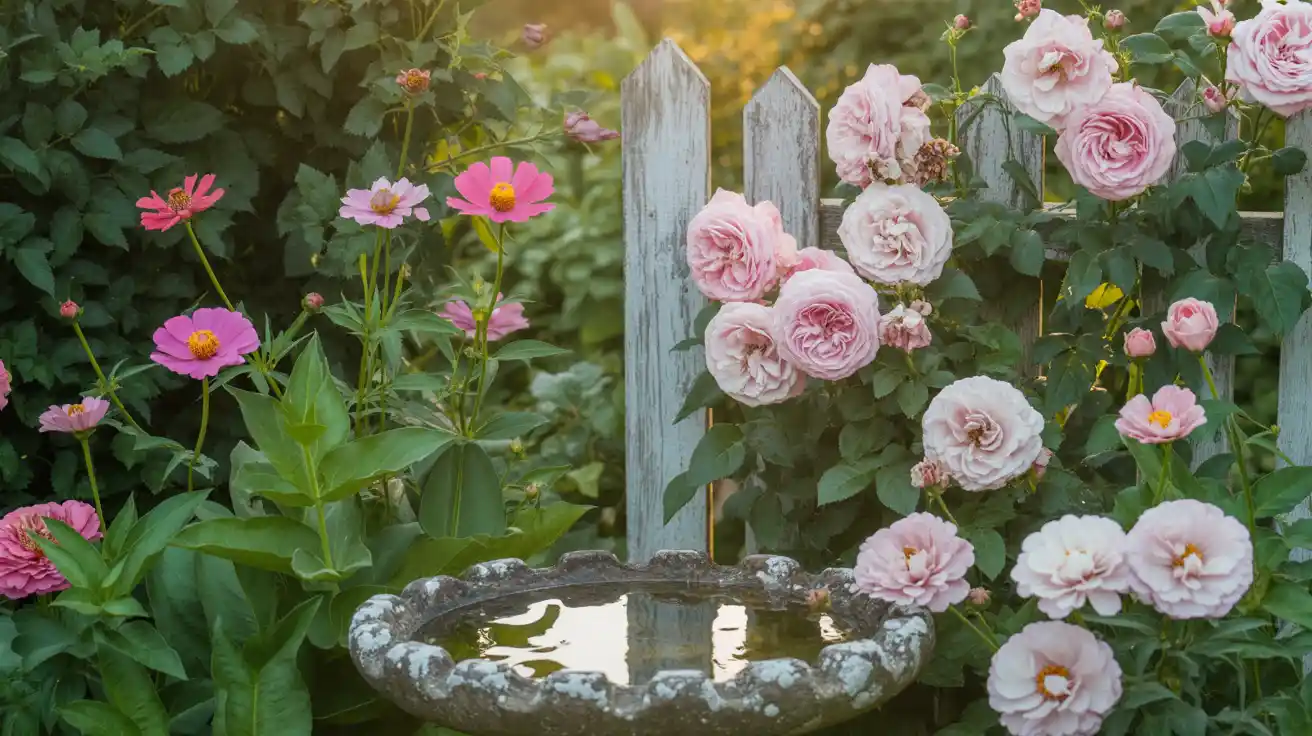
Whether you’re going for cottage garden charm or modern minimalist vibes, there’s a pink bloom that’ll work perfectly in your space.
Today, I’m sharing my top 12 pink flower picks that have never failed to bring a smile to my face (and compliments from the neighbors).
What Makes Pink Flowers So Special in Garden Design?
Pink flowers are like the perfect middle ground between bold red statement pieces and pure white elegance.
They add warmth without being overwhelming, and they play beautifully with almost every other color in your garden palette.
In my opinion, pink blooms are the ultimate team players—they make yellows pop, complement purples beautifully, and create stunning contrast against deep green foliage.
From a design perspective, pink flowers can serve multiple roles. Light pinks create soft, dreamy backgrounds, while hot pinks add vibrant focal points.
You can use them to create color gradients (picture a drift of flowers flowing from pale blush to deep rose—absolutely gorgeous!) or as accent colors throughout your beds.
12 Pink Flower Varieties That’ll Transform Your Garden
1. Pink Peonies – The Garden Royalty

Peonies are hands-down my favorite spring showstoppers. These fluffy, fragrant blooms come in shades from the palest shell pink to deep coral, and they’re surprisingly easy to grow once established.
Best varieties to try:
- ‘Sarah Bernhardt’ (soft pink, incredibly fragrant)
- ‘Bowl of Beauty’ (pink petals with creamy centers)
- ‘Coral Charm’ (peachy-pink that fades to cream)
Growing tips: Plant them in fall, give them full sun to partial shade, and be patient—they can take 2-3 years to really hit their stride, but they’re worth the wait!
2. Pink Roses – The Classic Choice

I know, I know—roses can seem intimidating, but modern varieties are much more disease-resistant and easier to care for than their finicky ancestors.
Pink roses range from barely-there blush to vibrant fuchsia.
My go-to pink rose varieties:
- ‘Knockout’ roses (low-maintenance, repeat blooming)
- ‘Eden’ climbing rose (white with pink edges—stunning on fences!)
- ‘Queen Elizabeth’ grandiflora (tall, elegant, perfect for back borders)
Pro tip: If you’re new to roses, start with shrub roses or landscape roses—they’re much more forgiving than hybrid teas.
3. Pink Cosmos – The Cottage Garden Darling
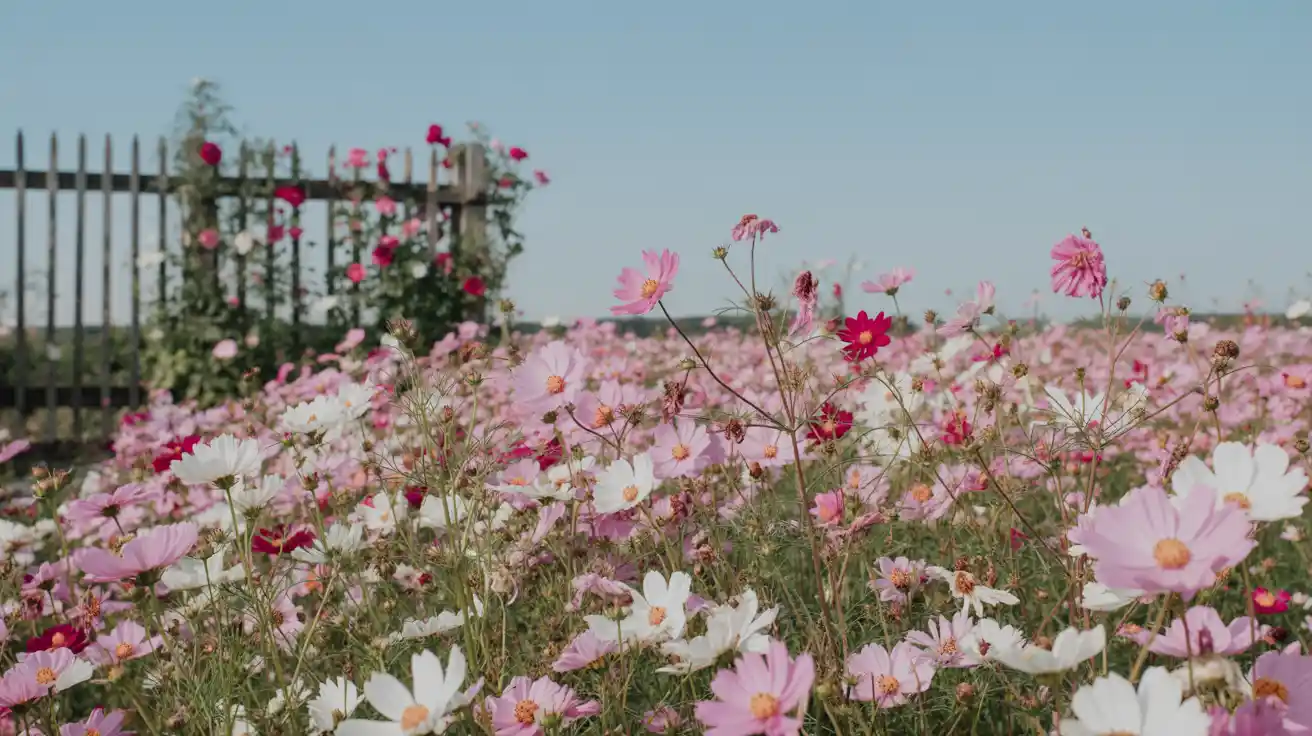
These delicate, daisy-like flowers are absolute workhorses in my garden.
Cosmos are annuals, which means you’ll need to replant them each year, but they self-seed readily (translation: they’ll likely come back on their own if you let some flowers go to seed).
Why I love them:
- They bloom from summer until frost
- They attract butterflies like crazy
- They’re drought-tolerant once established
- Perfect for cutting gardens
Growing note: Direct sow seeds in spring after your last frost date. They actually prefer poor soil (too much fertilizer makes them leafy but not very floriferous).
4. Pink Tulips – Spring’s First Blush
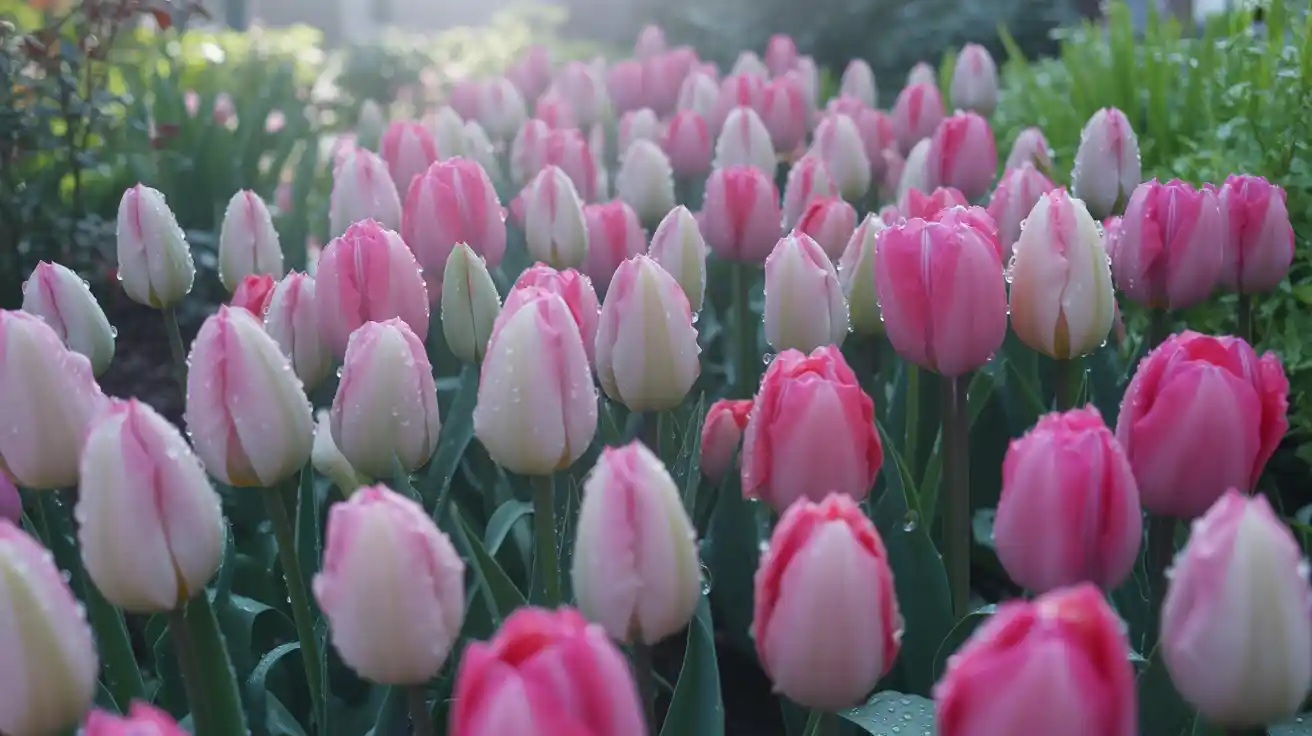
Nothing says “spring is here!” quite like tulips pushing up through the soil. Pink tulips come in every shade imaginable, from soft pastels to vibrant magentas.
Planting strategy I swear by:
- Plant bulbs in fall (6-8 weeks before hard frost)
- Choose a mix of early, mid, and late-season varieties for extended bloom time
- Plant them 6 inches deep and 4-6 inches apart
- Add bone meal to the planting holes for extra nutrition
Variety suggestions: ‘Pink Impression’ (Darwin hybrid, long-lasting), ‘Angelique’ (double, peony-like), ‘Pink Diamond’ (lily-flowered, elegant pointed petals).
5. Pink Zinnias – The Heat-Loving Showoffs
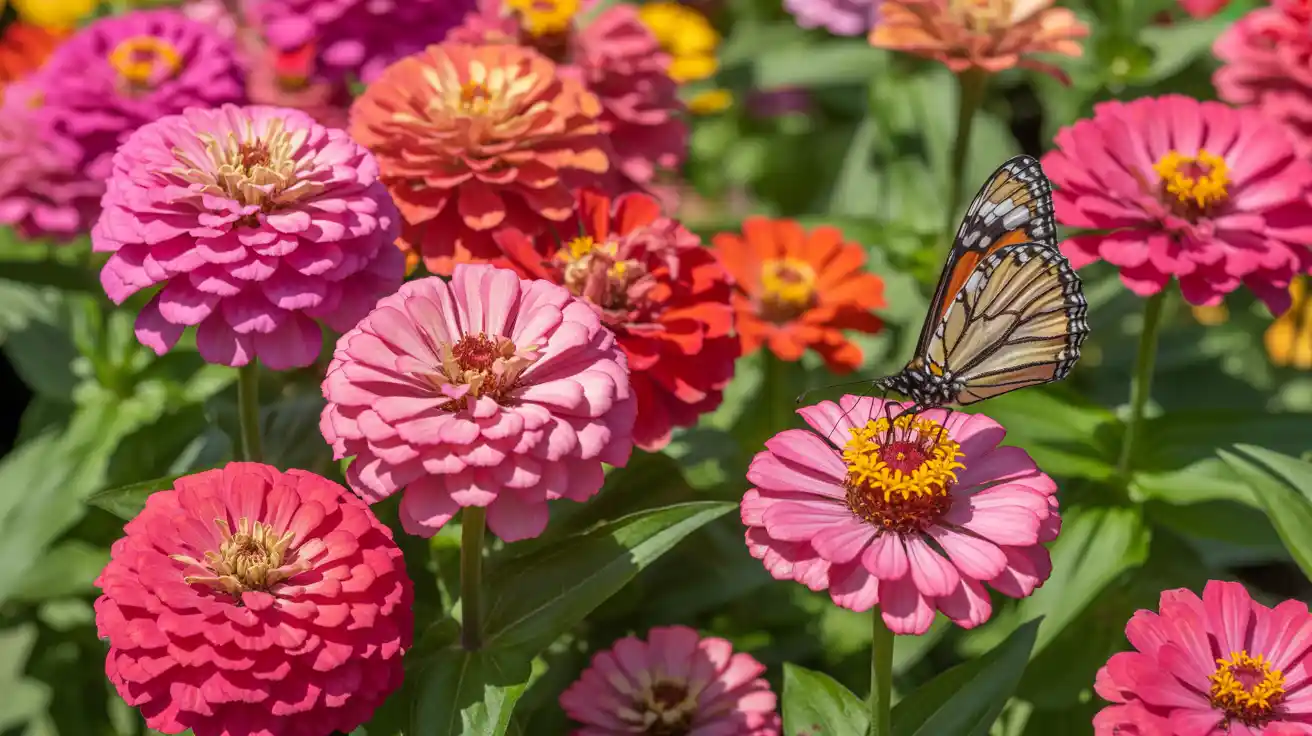
If you live somewhere with hot summers (like I do here in the South), zinnias are your best friend. These colorful annuals thrive in heat and humidity, blooming nonstop from summer through fall.
What makes them special:
- Available in dozens of pink shades
- Great for beginners (seriously foolproof)
- Excellent cut flowers
- Butterflies and bees love them
Growing tips: Start from seed directly in the garden after the soil warms up. They don’t like to be transplanted, so skip the indoor seed starting unless you use biodegradable pots.
6. Pink Hydrangeas – The Mood Ring Flowers
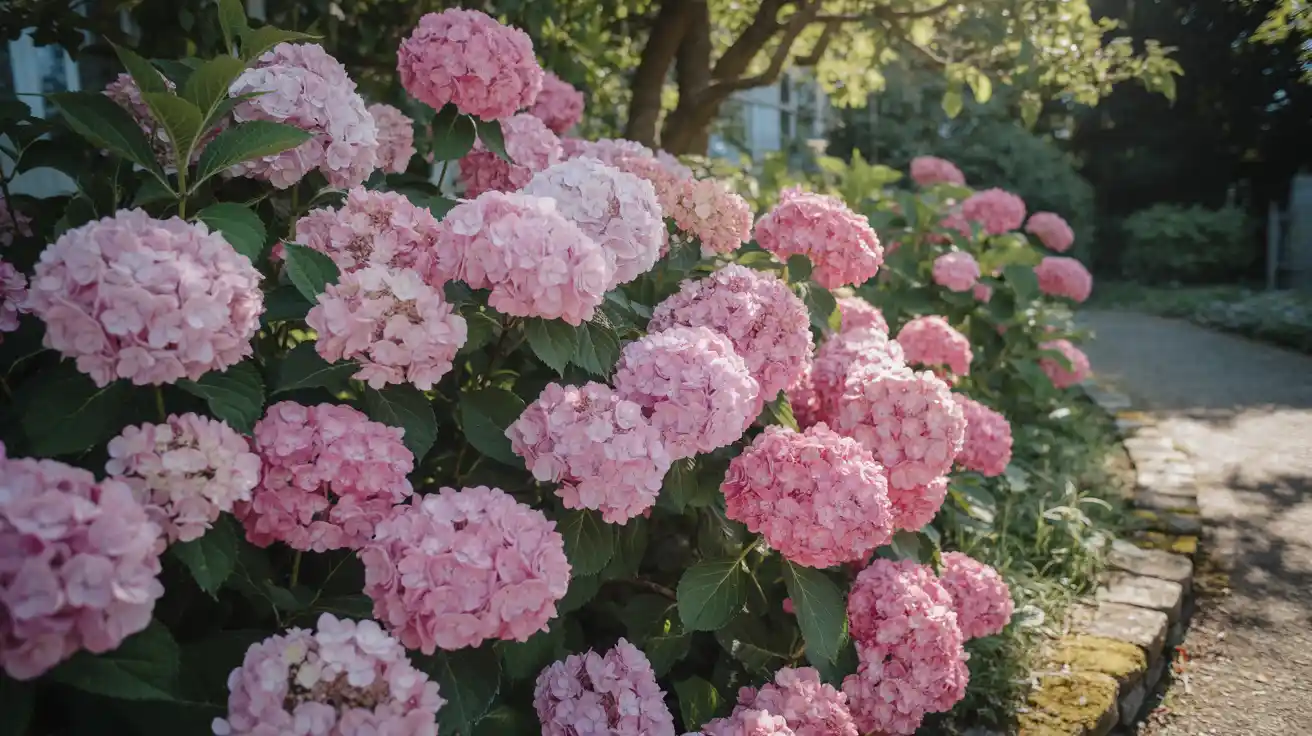
Here’s something fascinating about hydrangeas: their color can change based on your soil pH! In acidic soil (pH below 7), pink hydrangeas might turn blue or purple. In alkaline soil, they’ll stay beautifully pink.
Best pink hydrangea varieties:
- ‘Endless Summer’ (reblooming, great for beginners)
- ‘Incrediball Blush’ (huge white flowers that age to pink)
- ‘Little Lime Punch’ (compact, flowers start green and turn pink)
My color-control trick: If you want to keep them pink, add lime to your soil to make it more alkaline. Test your soil pH first—most garden centers sell simple test kits.
7. Pink Impatiens – The Shade Garden Superstars
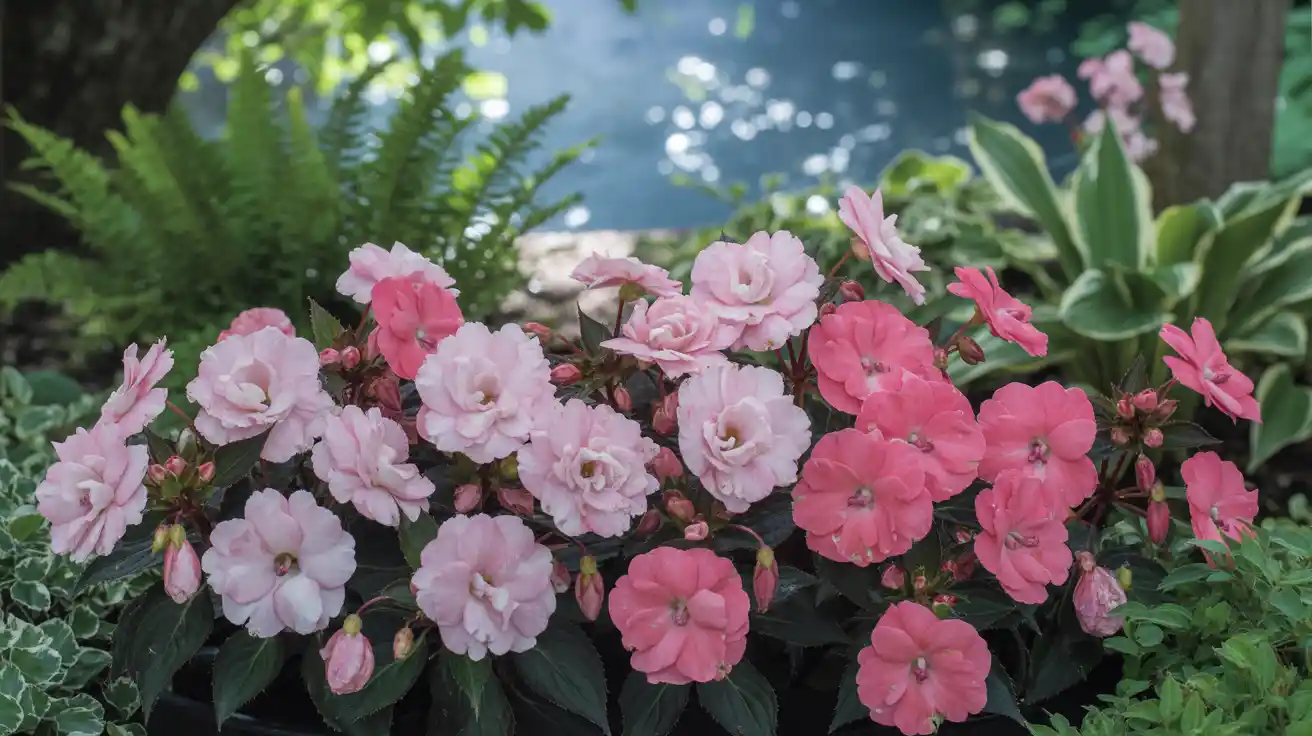
For those tricky, shady spots in your garden, impatiens are absolute lifesavers. These tender annuals (meaning they won’t survive frost) bloom continuously in partial to full shade.
Two main types to know:
- Busy Lizzies (traditional impatiens, more compact)
- New Guinea impatiens (larger flowers, more sun-tolerant, variegated foliage options)
Care is super simple: Keep them consistently moist (but not waterlogged), and they’ll bloom their hearts out all season. I like to plant them in containers on my covered porch where I can enjoy them up close.
8. Pink Petunias – The Hanging Basket Heroes

Petunias are the ultimate container flower, in my opinion. They spill beautifully over the edges of hanging baskets and window boxes, creating those gorgeous cascading displays you see on Pinterest.
Types to consider:
- Grandiflora (large, showy flowers)
- Multiflora (smaller flowers, more weather-resistant)
- Wave petunias (spreading habit, perfect for ground cover)
Maintenance tip: Pinch off spent flowers regularly (called deadheading) to keep them blooming. If they get leggy mid-summer, don’t be afraid to cut them back by half—they’ll bounce back stronger!
9. Pink Dianthus – The Spicy-Sweet Charmers
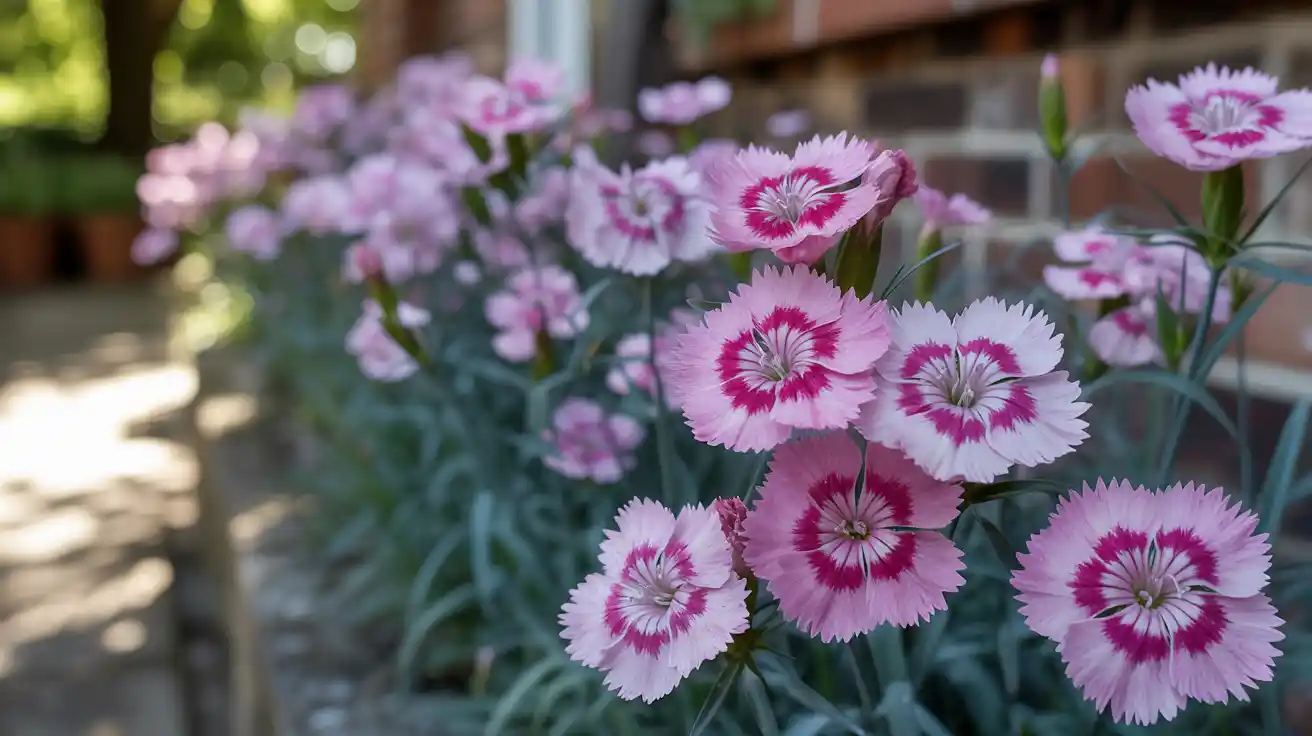
Dianthus (also called pinks or carnations) has the most amazing clove-like fragrance. These perennials come back year after year, forming neat, compact clumps perfect for border edges.
What I love about them:
- Incredibly fragrant (especially in the evening)
- Drought-tolerant once established
- Deer resistant
- Long blooming period
Growing requirements: They prefer well-draining soil and full sun to partial shade. If your soil is heavy clay (like mine was originally), work in some compost or sand to improve drainage.
10. Pink Begonias – The Reliable Performers
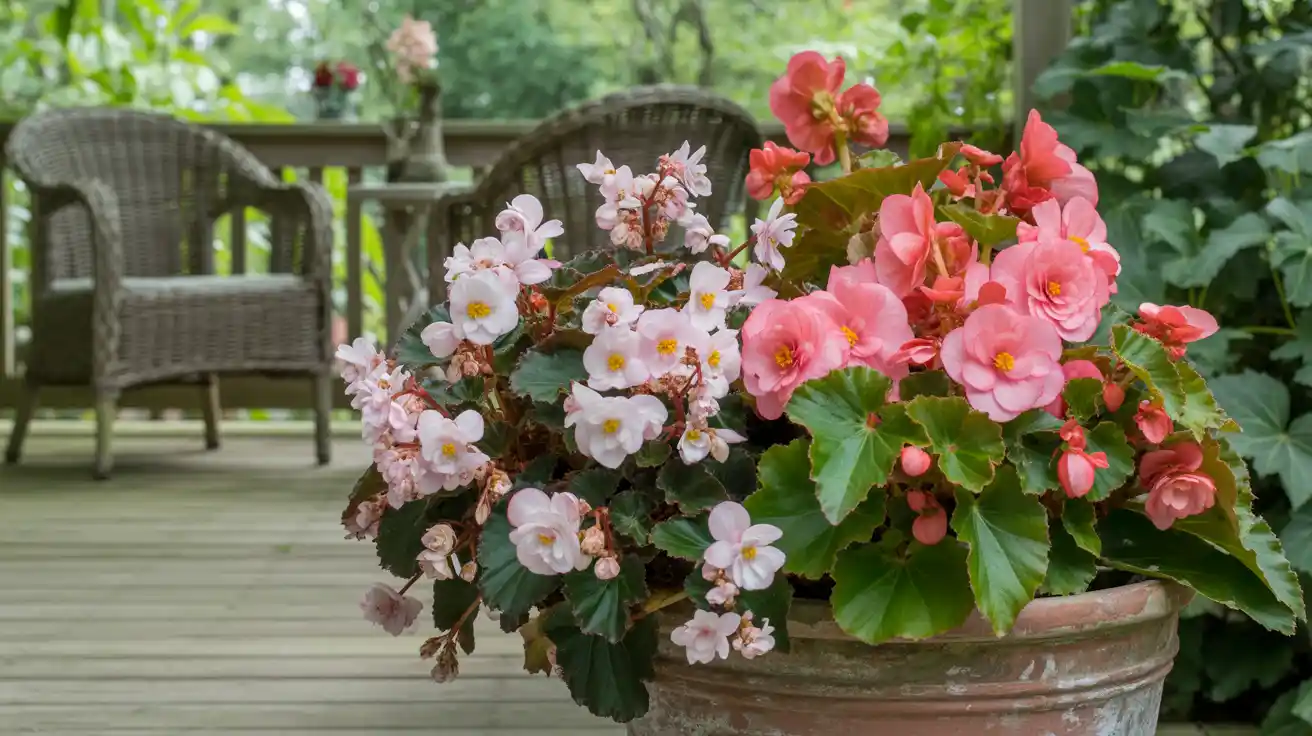
Begonias are like the dependable friend of the flower world—they might not be the flashiest, but they’re always there for you! These shade-loving annuals bloom consistently from spring until frost.
Two main categories:
- Fibrous begonias (also called wax begonias, small flowers, continuous bloom)
- Tuberous begonias (larger, more dramatic flowers, perfect for hanging baskets)
Planting tip: Wait until nighttime temperatures consistently stay above 50°F before planting outside. They’re tropical plants at heart and don’t appreciate cool weather.
11. Pink Astilbe – The Feathery Shade Beauties

Picture fluffy, feather-like plumes dancing above fern-like foliage—that’s astilbe! These perennials are perfect for adding texture and height to shady garden areas.
Why they’re garden gold:
- Thrive in partial to full shade
- Beautiful foliage even when not blooming
- Come back reliably each year
- Available in heights from 8 inches to 4 feet
Care notes: They prefer consistently moist (but not soggy) soil and appreciate a layer of mulch to keep their roots cool. In the Zone 7 garden, they bloom from late spring to early summer.
12. Pink Caladiums – The Foliage Showstoppers
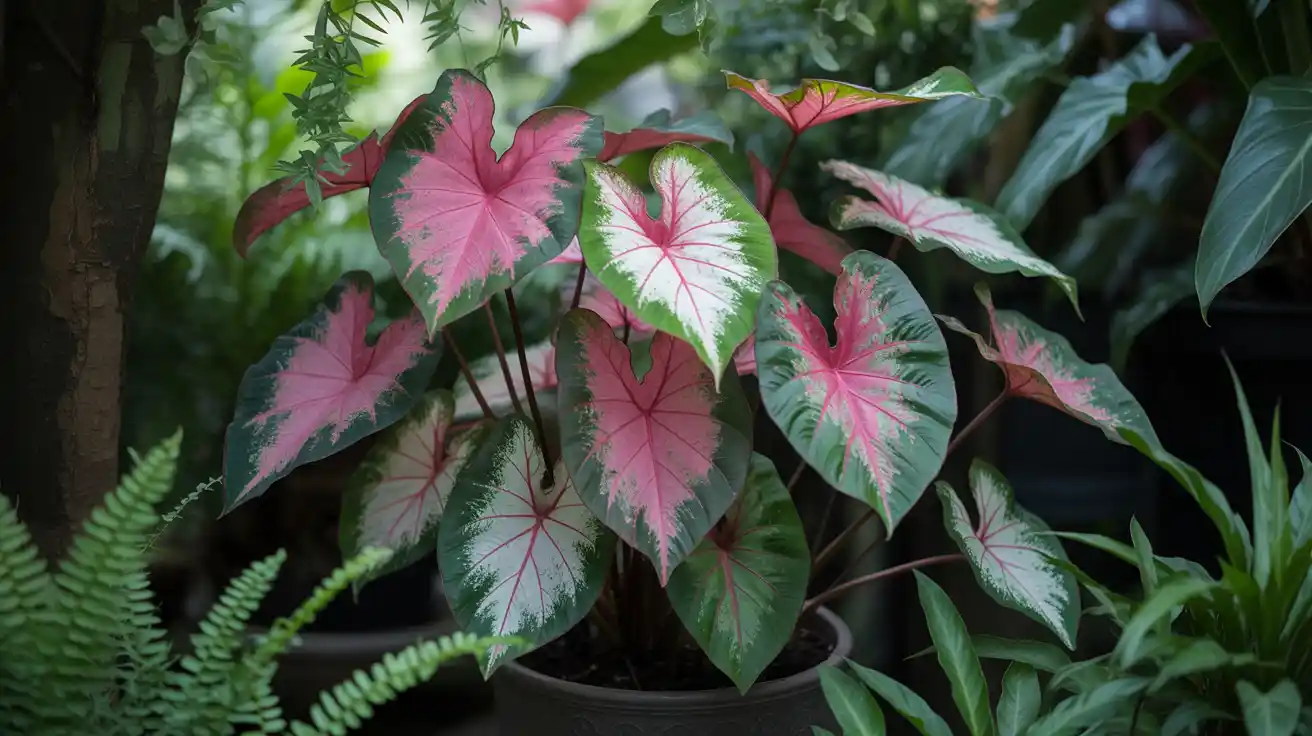
Okay, technically these aren’t flowers, but the heart-shaped leaves of pink caladiums are so stunning, they deserve a spot on this list! These tropical bulbs create incredible color displays in shaded areas.
What makes them special:
- Heart-shaped leaves in various pink and green combinations
- Perfect for containers or garden beds
- Thrive in shade to partial shade
- Create instant tropical vibes
Seasonal note: In colder climates, you’ll need to dig up the bulbs in fall and store them indoors over winter. In warmer zones (9-11), they can stay in the ground year-round.
How to Design with Pink Flowers for Maximum Impact
Creating a cohesive pink flower garden isn’t just about planting every pink flower you can find (though I’ve definitely been tempted to try that approach!). Here’s my tried-and-true strategy for designing with pink blooms:
Start with a Color Palette
I like to choose 2-3 shades of pink as my foundation. For example:
- Soft blush pink + coral pink + deep rose
- Hot pink + pale pink + salmon pink
- Dusty rose + mauve + bright fuchsia
Consider Bloom Times
Plan for continuous color by choosing flowers that bloom at different times:
- Spring: Pink tulips, cherry blossoms, azaleas
- Early summer: Peonies, roses, sweet Williams
- Mid-summer: Zinnias, cosmos, petunias
- Late summer/fall: Asters, mums, late-blooming roses
Mix Flower Shapes and Textures
Combine different flower forms for visual interest:
- Round, full flowers (peonies, roses)
- Spiky textures (astilbe, salvia)
- Delicate, airy blooms (cosmos, baby’s breath)
- Trumpet shapes (petunias, morning glories)
Tips for Growing Healthy Pink Flowers
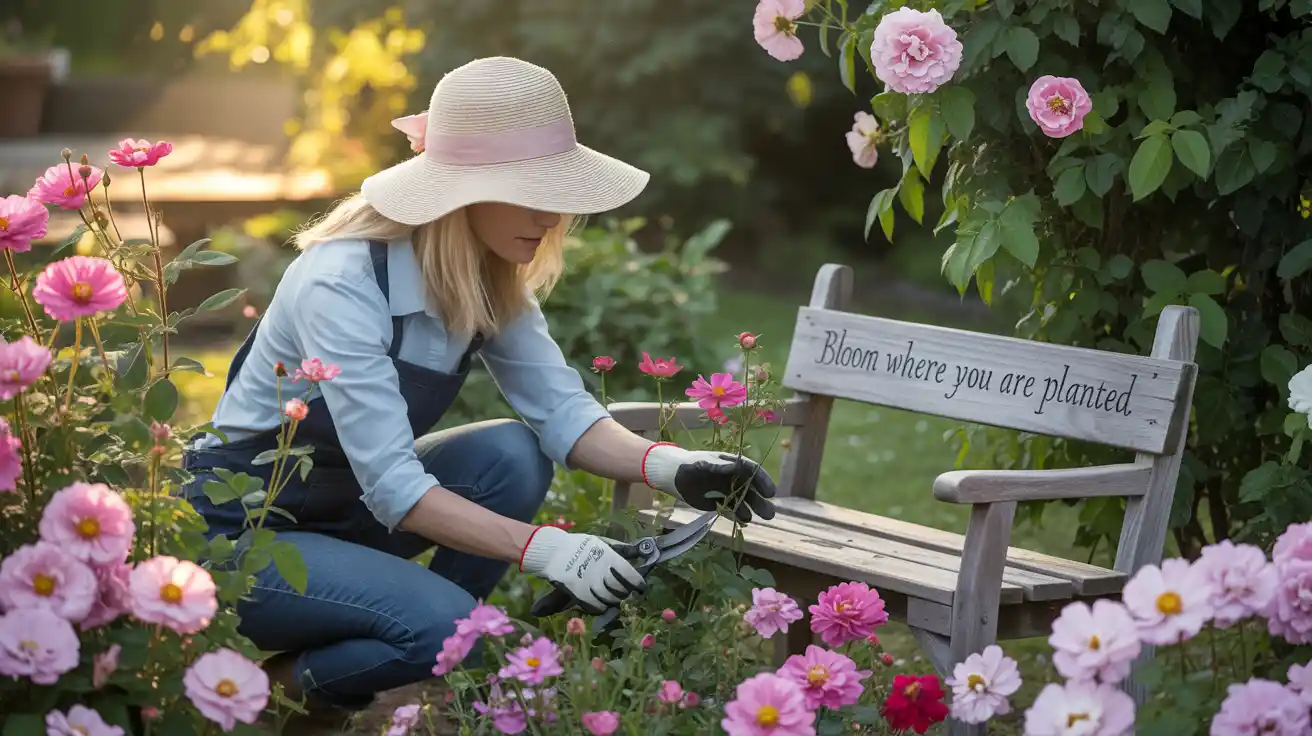
After years of trial and error (emphasis on the error part!), here are my best tips for keeping pink flowers happy and blooming:
Soil Preparation is Everything
Most flowers prefer well-draining soil with organic matter.
I always add compost to my planting areas—it’s like vitamins for your plants!
If you’re not sure about your soil quality, get it tested through your local extension office.
Timing Matters
For annuals: Wait until after your last frost date to plant tender annuals outside. I learned this the hard way when a surprise late frost killed my entire flat of impatiens!
For perennials: Spring and fall are typically the best planting times, giving roots time to establish before extreme weather.
Watering Wisdom
Water deeply but less frequently, rather than shallowly, daily.
This encourages roots to grow deeper, making plants more drought-tolerant. Early morning watering is ideal—it gives plants time to dry before evening (which helps prevent fungal diseases).
Feed Them Right
Most flowering plants benefit from regular feeding during their growing season. I use a balanced, slow-release fertilizer in spring, then supplement with liquid fertilizer every few weeks during peak growing season.
Pro tip: too much nitrogen makes plants leafy but reduces flowering!
Seasonal Care Tips for Pink Flower Gardens
Spring Tasks:
- Clean up winter debris around perennials
- Apply fresh mulch (2-3 inches, keeping it away from plant stems)
- Plant new additions after the soil warms up
- Start fertilizing established plants
Summer Maintenance:
- Deadhead spent blooms regularly
- Water during dry spells (aim for 1 inch per week, including rainfall)
- Watch for pest problems and address them early
- Take lots of photos for Pinterest inspiration!
Fall Preparation:
- Plant spring bulbs for next year’s display
- Collect seeds from annual flowers
- Cut back spent perennials (or leave them for winter interest and bird food)
- Mulch tender plants for winter protection
What to Expect: A Year in Your Pink Flower Garden
Your first year might feel a bit sparse—that’s normal!
Perennials are often described as “sleep, creep, leap,” meaning they spend their first year getting established, second year growing modestly, and third year taking off.
Annuals, on the other hand, will give you instant gratification.
They’re bred to bloom continuously, so you’ll have color from planting until frost. If you’re impatient like me, start with a mix of both for immediate impact and long-term payoff.
Troubleshooting Common Pink Flower Problems
- Problem: Flowers are fading or turning white
- Solution: This often happens in intense heat. Provide afternoon shade or choose heat-tolerant varieties.
- Problem: Plants are leggy with few flowers
- Solution: Usually means too much shade or too much nitrogen fertilizer. Move to a sunnier spot or switch to a phosphorus-rich fertilizer.
- Problem: Leaves are turning yellow
- Solution: Could be overwatering, underwatering, or natural aging. Check soil moisture and adjust watering accordingly.
Your Pink Paradise Awaits
Creating a garden filled with beautiful pink blooms has been one of my most rewarding gardening adventures.
There’s something magical about stepping outside and being greeted by waves of soft, romantic color that just makes everything feel more hopeful and joyful.
Remember, gardening is a journey, not a destination. Don’t worry if everything doesn’t look picture-perfect right away (mine certainly didn’t!).
Start with one or two varieties that appeal to you, learn what works in your specific conditions, and gradually expand from there.
Whether you’re dreaming of a cottage garden overflowing with pink roses and cosmos, or a modern landscape with architectural pink grasses and minimalist plantings, there’s a pink flower combination that’ll make your heart sing.
The key is to start somewhere and let your garden evolve naturally.
So grab your gardening gloves, pick out a few of these gorgeous pink beauties, and get ready to create your own little slice of paradise.
Trust me, your future self will thank you!
And who knows? Maybe you’ll inspire someone else to fall in love with the magic of pink flowers, just like my grandmother did for me all those years ago.
Happy planting, friends! I can’t wait to see what beautiful pink creations you come up with. 🌸
